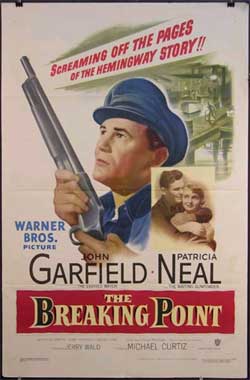Haves and Have Nots: Noir City Festival (Part 2)
 |
A man alone ain't got no chance.
-- John Garfield, The Breaking Point
[Warning: spoilers follow.]
Here's looking at you, kid: time and endless reruns have cemented Humphrey Bogart in our minds as the preeminent star of the 40's -- and perhaps nothing sticks to the roof of the mind as much as his duets with Lauren Bacall in The Big Sleep (1946) and To Have and Have Not (1944). In the brash, confident flush of post-World War II America, Bogey and Bacall were a wisecracking, wised-up dream team, swaying with uncomplicated masculinity and sassy femininity. The details of Howard Hawks' To Have and Have Not, based very loosely on Hemingway's book, disappear from memory, but still we recall the moment Bacall first asks Bogart for a cigarette, or rolls out the "You do know how to whistle?" line on him.
In stark contrast to the undeniable entertainment value of the above, we have The Breaking Point, the second adaptation of "To Have and Have Not." Inevitably lost in the shadows of its predecessor, this film nevertheless has an impressive pedigree: John Garfield (The Postman Always Rings Twice) assuming the role of the beleagured Harry Morgan, Patricia Neal as would-be femme fatale Lenora Charles, and Michael Curtiz (The Adventures of the Robin Hood, Casablanca) at the helm. The result is a modest but bracing antidote to the confident swagger of Hawks' version -- and it is quite telling that the film came out six years after To Have and Have Not, at a time when America found itself in full post-war malaise. One wonders how Papa Hemingway, himself given to inflating his own myth, reacted to Curtiz and Garfield's unromanticized take on his source material -- maybe he would have winced and raised a drunken toast to Hawks and Bogey, hard men to the finish. Nevertheless, Curtiz's film dives into the contradiction at the heart of every Hemingway hero -- for all their bluster, tough guy poses, and self-reliance, his protagonists are very vulnerable, indeed, whether it's to the wiles of the soft life, a soft dame, or their own inflexible moral codes. In short, the quintessential noir hero.
Curtiz hews closely to the original Hemingway story, and its episodic twists and turns (apparently, Hawks dared Hemingway, "I can make a picture out of your worst story," thereby handing screenwriter William Faulkner carte blanche to blow it up and start over). Morgan (Garfield) and his African-American first mate Wesley Park (Juano Hernandez) ply their fishing boat trade in southern California, down on their money and luck, and both change for the even-worse when they meet up with Neal's gold-digging Lenora, as well as a conniving lawyer (Wallace Ford on twitch overdrive) who hooks Harry up with some illegal Chinese immigrants who need a ride to the US from Mexico. Transposed against these scenes of double-dealing, sexual temptation and illicit activity is the sane but nerve-wracking clamor of home life, as Harry's faithful wife Lucy (Phyllis Thaxter) tries to hold her disintegrating family (which includes two preciously annoying daughters) together.

Garfield, who would later become a prime victim of Senator McCarthy during the Red Scare of the 50s, portrays a wholly different Morgan than the Bogart version. With an economy of expression and dialogue, he embodies the proverbial man on the edge, caught between easy money and hard circumstances. Where Bogart cruises, he struggles. On either side of him are Neal and Thaxter, neither overpowering the other (although Neal does gain the upper hand when Thaxter dyes her hair platinum blond in a desperate attempt to win back her husband's affection). Thaxter has the more difficult role, but manages to bring some shades and even a degree of sexiness to her virtuous housewife. Neal slinks and purrs her wisecracks flawlessly, while at the same time suggesting a pinched fatalism in her anxious stares, the set of her jaw. A good-time gal, she ain't.
Despite the sunny climates, the clear waters, and the fleeting moments of happiness (greeting the neighbors in the morning, shared alcohol and confidences in bars and upper-class suites), one feels the drain of the hardscrabble life, the spiral of bad mistakes compounding each other.
 |
Even more startling is the death of Juano Hernandez's Wesley, as shocking now as it was then. It's become commonplace for the friendly minority sidekick to get offed in the course of a movie, but Garfield (who was quite leftist in his opinions and causes, and apparently insisted on a greater role for Hernandez) goes one step further: the murder is unnecessary and brutally casual, like a sucker punch to the gut. To top it off, the final shot of the movie is not of the heroic captain wheeled off the dock in the arms of his loving wife, nor of the conniving temptress who accepts the fact that she is alone, after all. No, instead we have a God's-eye view of Wesley's son, bewildered at his father's disappearance (for no one has told him he is dead), waiting alone on the dock for him. For a movie that examines the price of living and finds the cost to be cheap, it is a shattering finale. Unflinching in its depiction of sad sacks and wannabes, The Breaking Point won't be remembered for its quotable dialogue or star power, but it gets closer to the restless futility of Hemingway than almost any other film based on his works -- and it's a pretty good tale of criminals and ordinary joes, too.

